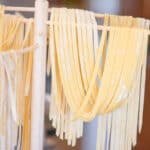Homemade Pasta
Homemade Pasta is not only fun and easy recipe to make in your own kitchen, but nothing compares to the taste and texture of fresh homemade pasta. Whether you want to knead and cut the dough by hand, or you use a kitchenaid to mix and a roller to flatten and cut, I'll share all of my homemade pasta tips & tricks!
Servings: 12 servings
Ingredients
- 1 1/2 cups semolina pasta flour
- 1 1/2 cups all purpose flour
- 4 eggs room temperature and slightly beaten
- 4 tablespoons olive oil
- 4 tablespoons water
- 1 teaspoon salt
Instructions
Homemade pasta can either be made by hand or in a stand mixer.
- If making by hand: Combine 1 1/2 cups semolina pasta flour, 1 1/2 cups all purpose flour, 4 eggs, 4 tablespoons water, 4 tablespoons olive oil, and 1 teaspoon salt. Mix to make a stiff dough. Knead 10 minutes by hand.
- If using a stand mixer: Combine 1 1/2 cups semolina pasta flour, 1 1/2 cups all purpose flour, 4 eggs, 4 tablespoons water, 1 teaspoon salt and 4 tablespoons olive oil in stand mixer bowl. Knead on medium speed with a dough hook.
- If dough is too sticky, sprinkle on additional semolina until it comes together. If dough is too dry, sprinkle water until you get the right consistency. You'll want to knead until the dough is elastic. Slice into the dough with a paring knife; if you see lots of air bubbles, keep kneading. The dough is kneaded when it forms a smooth elastic ball and has very few air bubbles when cut. Test by pressing your knuckle into the dough; if it starts to bounce back then it's ready.
- Wrap dough in plastic wrap or in a covered bowl and let rest for at least 30 minutes.
Rolling and cutting the dough:
- On a lightly floured surface roll out to desired thickness and cut as desired. Alternatively, cut into small chunks, flour, and roll through pasta roller. For this process, send through on thickness of 0. Fold in thirds and rotate so that straight edges are on the side and send it through again. Fold in thirds once more, again with straight edges on sides, and then send it through thickness 0 for a third pass. Then, change thickness to 1 and send dough through once. Continue process stepping through thicknesses 2, 3, 4 and end with 5. Give dough sheet one last dip in flour and then run it through the fettucine cutting side.
- You can dredge pasta in flour to ensure it doesn't stick together. Either set on cookie sheet until ready to cook or dry pasta on a drying rack.
- To cook, bring a large pot of heavily-salted water to a boil. Add pasta and cook until tender (approximately 3 - 5 minutes). When making lasagna, no need to boil noodles. Add directly to your recipe.
Video
Notes
Tips for using a pasta roller:
The same process works whether you use a hand roller or the KitchenAid attachment. I actually have the Atlas hand roller and highly recommend it. There's just something fun about cranking the pasta through manually.- Working with small pieces of well-floured dough, send through the roller on the widest setting. Fold the dough into thirds and send it back through with the folded ends on the sides. Do this one more time and send it through the widest setting. The reason you do this is to get a pasta sheet with straight edges so there's little waste when you cut.
- Continue to work the dough through the roller, rotating the dial each time to make the pasta sheet thinner and thinner. Ensure your dough always has enough flour so that it doesn't stick to your roller.
- I usually go to the thickness setting of 5, but you can choose how thick or how thin you want your pasta.
- Once you have your sheet, you can then make your own ravioli or lasagna. Again, having the right tools helps, so if you're making ravioli I recommend using a ravioli press. If you plan to cut spaghetti or linguine noodles, send the pasta through the cutting side.
- Ensure each of the noodles are well covered in flour so they don't stick. You can't go overboard here because it will all come off when you cook the pasta.
Nutrition
Calories: 194kcal | Carbohydrates: 27g | Protein: 6g | Fat: 6g | Saturated Fat: 1g | Cholesterol: 54mg | Sodium: 215mg | Potassium: 76mg | Fiber: 1g | Vitamin A: 80IU | Calcium: 14mg | Iron: 1.9mg
